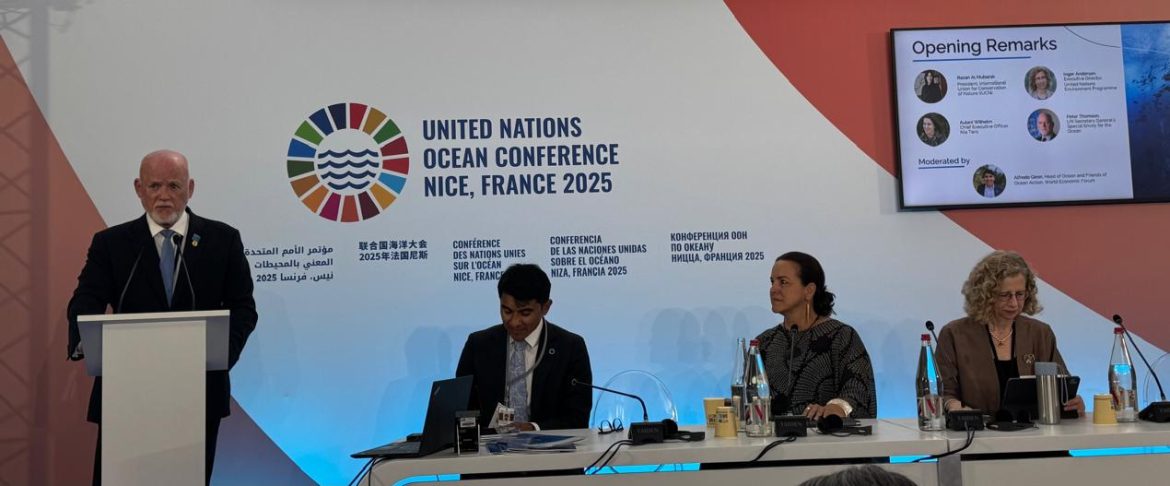By: Hadeer Elhadary – Nice, France
The UN Ocean Conference in Nice concluded with a powerful demonstration of global unity, as 170 nations adopted a political declaration reaffirming the critical 30×30 target, protecting 30% of the ocean and land by 2030. Central to the summit’s legacy was the launch of the Nice Ocean Action Plan, a comprehensive two-part strategy that combines political momentum with practical implementation. This plan encompasses over 800 voluntary commitments from governments, scientists, UN agencies, and civil society, aimed at accelerating marine protection through improved governance, inclusive financing, and science-based policies.
Significant progress was made on the High Seas Treaty, also known as the Biodiversity Beyond National Jurisdiction (BBNJ) agreement, with 19 new ratifications this week, bringing the total to 50—just ten short of the number required for enforcement.
The 30×30 Goal: A Landmark Initiative for Ocean Conservation
The 30×30 Ocean Action Plan aligns with the Kunming-Montreal Global Biodiversity Framework and marks a historic step toward protecting 30% of the world’s oceans by 2030.
In exclusive remarks to ESG Mena, Inger Andersen, Executive Director of the United Nations Environment Programme (UNEP), underscored the vital importance of this goal for human and planetary health. “Rainfall patterns, ocean regulation, and climate systems all depend on clean, unpolluted oceans free from carbon emissions and toxic runoff,” she explained.
Andersen acknowledged the critical role of fishing for coastal communities but clarified that marine protection leads to healthier, more sustainable fisheries— the essence of the 30×30 initiative. With only about 9% of the ocean currently protected, she stressed the urgent need for global cooperation: “If one country protects its ocean while another does not, the benefits are lost. Pollution and overfishing know no borders.”
She also highlighted Egypt as a key example, pointing to its rich coral reefs and vital fishing and tourism sectors along the Mediterranean and Red Sea coasts as natural and economic treasures requiring safeguarding for future generations.
Peter Thomson: “30×30 Is Not Just a Goal, It’s a Lifeline for the Planet
Commenting on the launch of the 30×30 Ocean Action Plan, Peter Thomson, the UN Secretary-General’s Special Envoy for the Ocean, described it as a pivotal moment in the global movement to safeguard marine biodiversity. “This is not just another document—it’s a call to action,” he said. Thomson emphasized that while only 8.3% of the ocean is currently under formal protection, the 30% target by 2030 remains achievable if bold leadership and collaboration are prioritized. “We chose 30% because the science was clear failing to protect at least that many risks triggering a catastrophic collapse of global biodiversity,” he explained.
He highlighted that the action plan offers a realistic, science-backed pathway, focusing on political will, community empowerment, and innovative financing mechanisms such as blended finance and marine insurance. “It’s a trillion-dollar opportunity hiding behind a $14 billion gap. The tools now exist—we simply need to deploy them at scale,” Thomson noted. He called on governments to prepare national 30×30 roadmaps ahead of the CBD COP17 summit and underscored that real ocean protection must be equitable, locally led, and deliver tangible outcomes. “As a grandfather of four girls, I say this to all young people: have hope in reason and let us turn progress into something real.”
Voices from Leadership: Urgency and Accountability
At the conference’s high-level opening, Her Excellency Razan Al Mubarak, UN Climate Change High-Level Champion for COP28 and President of the International Union for Conservation of Nature (IUCN), urged immediate action. “We are beyond urgency—it is now or never,” she declared, stressing that protecting at least 30% of oceans is non-negotiable for the planet’s health, societal prosperity, and climate resilience.
Al Mubarak called for swift ratification and implementation of the BBNJ Treaty, emphasizing that conservation is more than map boundaries — it requires real, equitable impact led by science and local communities, backed by good governance and sustainable financing. She further stressed that achieving 30×30 demands an “all-of-society” approach, with leadership from governments, philanthropy, private sectors, Indigenous peoples, and civil society alike.
Her remarks concluded with an invitation to join the momentum moving forward to the IUCN World Conservation Congress in Abu Dhabi this October, part of the ongoing “30 and Beyond” roadmap.
Implementation Challenges: From Ambition to Reality
Despite the ambitious 30×30 target, a UN report launched at the conference highlighted significant hurdles. These include entrenched economic systems favoring short-term gains, fragmented governance, underfunding, and weak enforcement of Marine Protected Areas (MPAs). Many MPAs exist only on paper, lacking local engagement, especially from Indigenous Peoples and Local Communities (IPLCs), whose stewardship is critical for success.
Financial gaps are glaring: only $1.2 billion is currently spent annually on ocean protection, a fraction of the estimated $15.8 billion needed. Developing and island nations often lack stable funding for effective MPA management, while political and institutional barriers slow progress.
Nevertheless, solutions are within reach through coordinated action and stronger cooperation, especially by leveraging momentum from agreements like the BBNJ Treaty and frameworks outlined in the new Nice Ocean Action Plan.
Current Status and Forward Path
Currently, about 8.3% of the ocean is designated as MPAs, but only 2.7% is fully or highly protected. Even if all proposed large MPAs are realized, coverage would reach just 12.3%, far short of the 30% goal. Bridging this gap requires both stronger global frameworks and accelerated local implementation where conditions allow.
Technology and scientific research also emerged as powerful enablers for monitoring protected areas and supporting data-driven decision-making. Enhanced satellite imaging, AI-powered tracking systems, and community-based marine science are playing a growing role in identifying threats and evaluating MPA effectiveness, helping countries prioritize interventions.
Another promising development is the integration of Indigenous knowledge into ocean governance. Indigenous Peoples and Local Communities are increasingly recognized as essential partners in marine conservation. Their ancestral knowledge, often overlooked in traditional policy frameworks, offers valuable insights for managing biodiversity and building resilient coastal ecosystems.
Financing the Blue Economy: A Critical Step
Daniela Fernandez, Founder and CEO of the Sustainable Ocean Alliance (SOA), highlighted the importance of mobilizing finance to support vulnerable coastal communities and ensure science-based policymaking. In an exclusive ESG Mena interview, Fernandez described the 30×30 plan as a “critical step toward accelerating implementation.”
“This isn’t just about pledges—it’s about building frameworks for real action. The key question now is: what’s the follow-up? How do we ensure governments, private sectors, and civil society remain accountable?” she asked. Fernandez called on stakeholders to be bold in leading true transformation.
Expressing optimism about the conference as a pivotal moment, she noted the ocean has been sidelined in climate discussions. “The ocean receives less than 1% of global climate financing, yet it offers some of the most powerful natural solutions to climate change.”
Addressing the financing gap, Fernandez announced the launch of Velamar, a new asset management platform designed to channel investments into the sustainable blue economy. “To meet the UN Sustainable Development Goals by 2030, we need around $170 billion annually, but current financing falls far short,” she said. “Before bringing in the right financial actors, we must first build the infrastructure for ocean finance—from grassroots to government and technological innovation.”
This story was produced as part of the 2025 UNOC Fellowship organized by Internews’ Earth Journalism Network.




